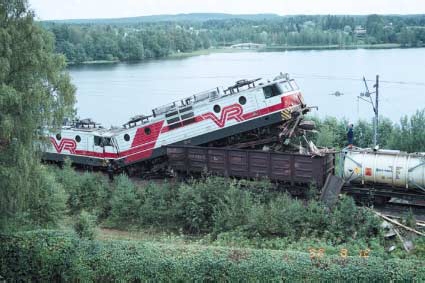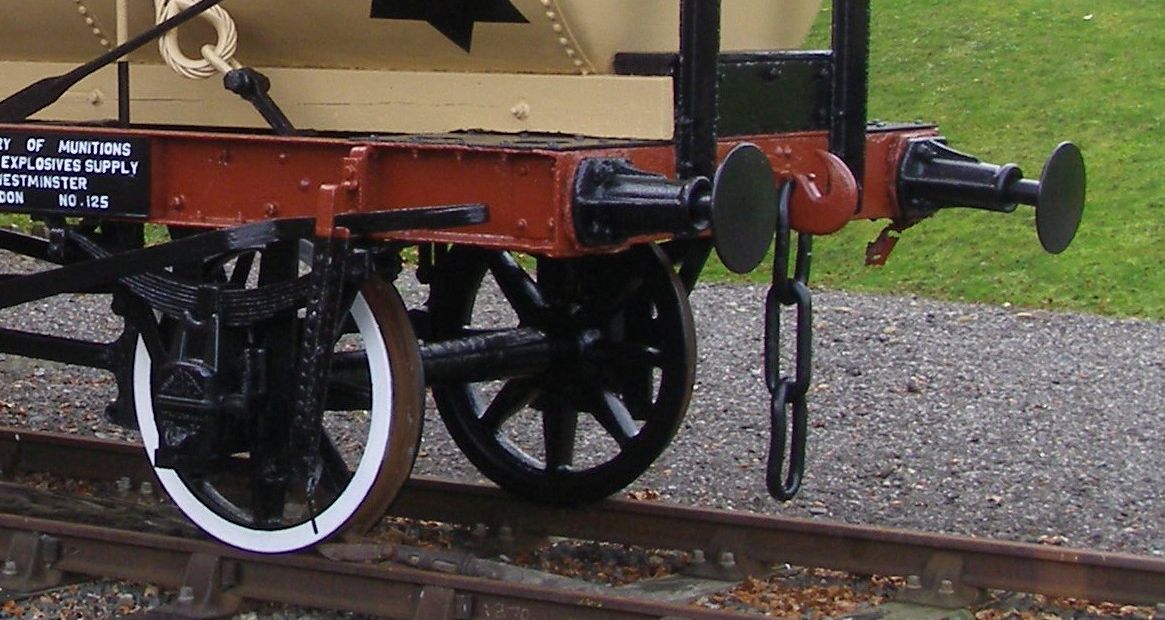|
VR Class Sr2
The Sr2 is a class of electric locomotives of the VR Group. They were built by SLM/ABB and later by Adtranz and finally Bombardier Transportation and assembled by Transtech Oy. They are closely based on the class Re 460 (or Lok 2000) locomotives of Swiss Federal Railways. The nicknames of this class are ''Alppiruusu'' (Edelweiss), ''Käkikello'' (Cuckoo clock), both referring to the Swiss origin of the locomotive, as well as ''Marsu'' (Guinea pig) and ''Möhkö'' (Blob), both from the looks of the locomotive. History In 1992, VR ordered the first 20 class Sr2 locomotives; later 20 more were ordered with 12 options. Finally only six of the 12 options were transformed into orders, forming a total fleet of 46 engines. The locomotives are used on both passenger trains and freight trains, and they are the primary locomotives of the fast InterCity trains in Finland. Until mid-2010s Sr2s were pulling IC trains the classic way, but after Edo-class cab control cars were introduced ... [...More Info...] [...Related Items...] OR: [Wikipedia] [Google] [Baidu] |
Tampere Railway Station
Tampere Central Station is a functionalist building in Tampere, Finland, designed by Eero Seppälä and Otto Flodin, completed in 1936. The station is one of the most important railway stations in Finland. In 2015, the Tampere Central Station was the second busiest railway station in Finland in terms of numbers of passengers, after the Helsinki Central Station. The 36-metre clock tower was later added because the Finnish railway bureau required it (its total height from ground level is about 50 metres). The city's main street Hämeenkatu begins at the railway station, continuing over the Hämeensilta bridge to its western end at the Aleksanteri Church. The Itsenäisyydenkatu (originally called Puolimatkankatu) street begins at the Tammela side of the station, continuing to the Kaleva Church.Iltanen, Jussi: ''Radan varrella: Suomen rautatieliikennepaikat'' (2nd edition), pp. 79-81. Finnish Map Bureau 2010. . Situated in a central location, the station and its railway yard ha ... [...More Info...] [...Related Items...] OR: [Wikipedia] [Google] [Baidu] |
Edelweiss
EDELWEISS (Expérience pour DEtecter Les WIMPs En Site Souterrain) is a dark matter search experiment located at the Modane Underground Laboratory in France. The experiment uses cryogenic detectors, measuring both the phonon and ionization signals produced by particle interactions in germanium crystals. This technique allows nuclear recoils events to be distinguished from electron recoil events. The EURECA project is a proposed future dark matter experiment, which will involve researchers from EDELWEISS and the CRESST dark matter search. Dark matter Dark matter is material which does not emit or absorb light. Measurements of the rotation curves of spiral galaxies suggest it makes up the majority of the mass of galaxies; and precision measurements of the cosmic microwave background radiation suggest it accounts for a significant fraction of the density of the Universe. A possible explanation of dark matter comes from particle physics. WIMP (Weakly Interacting Massive Par ... [...More Info...] [...Related Items...] OR: [Wikipedia] [Google] [Baidu] |
SLM Locomotives
SLM may refer to: ;Companies * SLM Corporation, or Sallie Mae, an American student loan company * Swiss Locomotive and Machine Works * Surinaamse Luchtvaart Maatschappij, or Surinam Airways, ICAO code * SLM International, later The Hockey Company * Stan Lee Media, an Internet company * St. Louis Music, equipment distributor ;Science * Selective laser melting, making metal parts * Spatial light modulator in optical projection * Standard litre per minute ;Other * Š-L-M (Shin-Lamedh-Mem), root of Semitic words * Salamanca Airport, Spain, IATA Airport Code * Sudan Liberation Movement The Sudan Liberation Movement/Army ( ar, حركة تحرير السودان ''Ḥarakat Taḥrīr Al-Sūdān''; abbreviated SLM, SLA, or SLM/A) is a Sudanese rebel group active in Darfur, Sudan. It was founded as the Darfur Liberation FrontFlin ... See also * {{disambiguation ... [...More Info...] [...Related Items...] OR: [Wikipedia] [Google] [Baidu] |
VR Class Sr1
The Sr1 is a class of electric locomotives built for VR of Finland. These 25 kV locomotives were built in the Soviet Union at the Novocherkassk Electric Locomotive Factory between 1973 and 1985. Two additional locomotives of this class were built at the VR Hyvinkää Hyvinkää (; sv, Hyvinge, ) is a city and municipality of Finland. It is located in the Uusimaa region, approximately north of the capital Helsinki. The city was chartered in 1960. The population of Hyvinkää is (). Its neighboring muni ... Machine Workshop in 1993 and 1995, number 3111 from spare parts and number 3112 from the original prototype locomotive (number 3000) that was never used by the VR. The official classification given by the manufacturer is VL70 or ES40. The nicknames for these locomotives are "''Siperian susi''" (Wolf of Siberia; in Finnish slang "susi" can also mean a poorly manufactured object, compare English "dog" or "lemon"), "''Kaalihäkki''" (Cabbage Cage) and "''Sähköryssä ... [...More Info...] [...Related Items...] OR: [Wikipedia] [Google] [Baidu] |
Railway Coupling
A coupling (or a coupler) is a mechanism typically placed at each end of a rolling stock, railway vehicle that connects them together to form a train. A variety of coupler types have been developed over the course of railway history. Key issues in their design include strength, reliability, ease of making connections and operator safety. The equipment that connects the couplings to the vehicles is the draft gear or draw gear and these must absorb the stresses of coupling and train acceleration. Nomenclature Compatible and similar couplings or couplers are frequently referred to using widely differing make, brand, or regional names, or nicknames, which can make describing standard or typical designs confusing. Dimensions and ratings noted in these articles are usually of nominal or typical components and systems, though standards and practices also vary widely with railway, region, and era. Buffers and chain The basic type of coupling on railways following the British trad ... [...More Info...] [...Related Items...] OR: [Wikipedia] [Google] [Baidu] |
SA3 Coupler
SA3 couplers (also known as СА3 or СА-3 couplers per the typical foundry stamp on top of these couplers, meaning "Советская Автосцепка, 3" in Russian or "Soviet Auto-latch 3" in English) or Willison coupler and Russian coupler are railway couplings used primarily in Russia and states influenced or not influenced by the former Soviet Union, such as Finland, Iran, Poland and Mongolia. Russian railways originally used buffers and chain couplers during Imperial era, however these had several disadvantages: their draft load was limited, they were susceptible to buffer lock, and they were not semiautomatic like the North American Janney couplers. Conversion to Janney couplers (as Japan and Australia had) was considered, as was development of a new design. The Willison coupler was patented in 1916 by John Willison from Derby, England. The Knorr-Bremse company bought it and it started to be used in Germany for some heavy trains and some suburban trains in ... [...More Info...] [...Related Items...] OR: [Wikipedia] [Google] [Baidu] |
Unilink Coupler
A coupling (or a coupler) is a mechanism typically placed at each end of a railway vehicle that connects them together to form a train. A variety of coupler types have been developed over the course of railway history. Key issues in their design include strength, reliability, ease of making connections and operator safety. The equipment that connects the couplings to the vehicles is the draft gear or draw gear and these must absorb the stresses of coupling and train acceleration. Nomenclature Compatible and similar couplings or couplers are frequently referred to using widely differing make, brand, or regional names, or nicknames, which can make describing standard or typical designs confusing. Dimensions and ratings noted in these articles are usually of nominal or typical components and systems, though standards and practices also vary widely with railway, region, and era. Buffers and chain The basic type of coupling on railways following the British tradition is the bu ... [...More Info...] [...Related Items...] OR: [Wikipedia] [Google] [Baidu] |
VR Class Sr3
VR Class Sr3 is the newest electric locomotive series used by VR Group. It is based on Vectron model, manufactured by Siemens Mobility. Sr3s are used with both passenger and freight trains and they will replace the old Sr1 electric locomotives. See also * VR Class Sr1 *VR Class Sr2 The Sr2 is a class of electric locomotives of the VR Group. They were built by SLM/ABB and later by Adtranz and finally Bombardier Transportation and assembled by Transtech Oy. They are closely based on the class Re 460 (or Lok 2000) locomoti ... ReferencesVR Group: Vectron locomotives for Finland (railcolor.net) External links * {{VR Group Electric locomotives of Finland VR locomotives 5 ft gauge locomotives Siemens locomotives ... [...More Info...] [...Related Items...] OR: [Wikipedia] [Google] [Baidu] |
InterCity
InterCity (commonly abbreviated ''IC'' on timetables and tickets) is the classification applied to certain long-distance passenger train services in Europe. Such trains (in contrast to regional, local, or commuter trains) generally call at major stations only. An international variant of the InterCity trains are the EuroCity (EC) trains which consist of high-standard coaches and are run by a variety of operators. History The Inter-City Rapid Transit Company was an Ohio interurban company, which began operations in 1930 as it had purchased its route from the Northern Ohio Traction & Light Company. It remained in operation till 1940. The use of ''Inter-City'' was reborn in the United Kingdom: A daily train of that name was introduced in 1950, running between the cities of London and Birmingham. This usage can claim to be the origin of all later usages worldwide. In 1966 British Rail introduced the brand InterCity for all of its express train routes, and in 1986 the ter ... [...More Info...] [...Related Items...] OR: [Wikipedia] [Google] [Baidu] |




.jpg)
